Ten Classic College Radio Albums

Sep. 13, 2023
For a few years in the mid-1980s, the trusty correlation between artistry and commerce in rock music seemed to break down. Many of the best and most influential bands of the era, from the Smiths to the Replacements to Hüsker Dü, failed to break through to Top 40 success or, like R.E.M., waited years to get there.
Yet, if you walked onto a college campus in the mid-'80s, those bands were everywhere, blaring out of dorm windows, spinning in heavy rotation on college-radio stations at the left of the dial.
Here are 10 great albums of the college-radio era. The list could go on forever, so we'll limit ourselves to LPs that came out between 1983 and 1986, that figured in Robert Christgau's influential yearend Pazz & Jop polls (a measure of impact), and that represent the artist's best work.
(And if you enjoy this piece, consider reading our previous entry on great albums of the new wave era.)
White males dominate the following list, just as they dominated the college-radio underground. Prince, Michael Jackson, Madonna and Run-D.M.C. all released classic albums in those years. They achieved massive, immediate commercial success, and quite rightly so. The discs below did not.
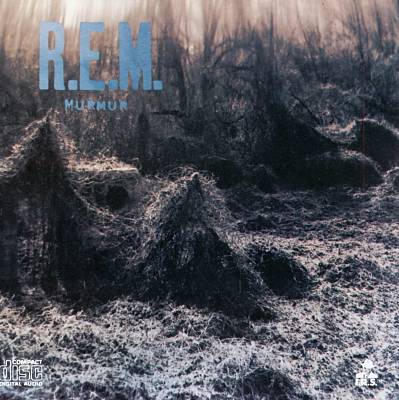 Murmur - R.E.M., April 1983.
Murmur - R.E.M., April 1983.
The release of the first R.E.M. album feels, in hindsight, like the moment college radio arrived. Here was a record filled with brilliant songwriting, infectious hooks, top-drawer vocals and an entirely accessible sound, the qualities that could reliably propel a pop act to fame in prior decades. And the album sold well enough, peaking at No. 36 on the Billboard 200 album chart and yielding a (very) minor hit with "Radio Free Europe." But you weren't going to hear R.E.M. on pop radio, nor see them on MTV. Hence, college radio. Murmur went into heavy rotation on campus radio stations and blasted out of dorm-room speakers. For a large quotient of mid-'80s college students, there was no bigger band.
Also recommended: Each of the three subsequent R.E.M. albums, in gently descending order: Reckoning, Fables of the Reconstruction and Lifes Rich Pageant; and the marvelous Chronic Town EP.
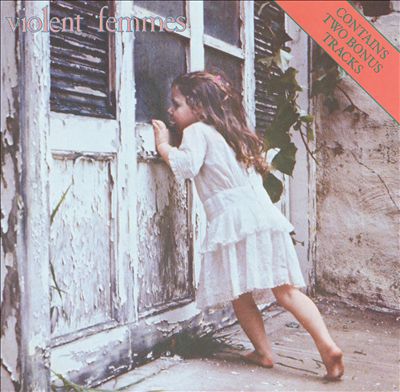 Violent Femmes - Violent Femmes, April 1983.
Violent Femmes - Violent Femmes, April 1983.
The Violent Femmes debut dropped a day after Murmur, and what a week for young hipsters with stereos. "Blister in the Sun," "Add it Up, "Prove My Love" and "Gone Daddy Gone" are immortal folk-punk anthems, utterly irresistible. Violent Femmes may have been the third-best album of 1983, after Murmur and Michael Jackson's Thriller, although the annual Pazz & Jop poll put it at 26.
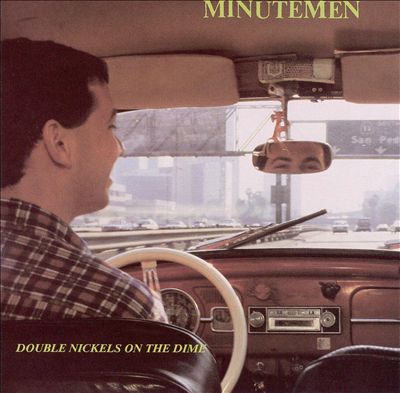 Double Nickels on the Dime - Minutemen, July 1984.
Double Nickels on the Dime - Minutemen, July 1984.
The idea of a double album from a band called "Minutemen" is funny in itself. (What is that, 80 songs?) But the Minutemen drew inspiration from a pitched creative battle with their talented SST Records labelmates, Hüsker Dü and the Meat Puppets. (See below.) The San Pedro boys were the most down-to-earth of the bunch: When I arrived at Mike Watt's house for an interview, years later, he literally lobbed his bass at me. God help me if I hadn't caught it. Every Minuteman album is good, but this one is probably the best. You get the deathless classics "Corona," "This Ain't No Picnic," "Jesus and Tequila" and, of course, "Political Song for Michael Jackson to Sing."
Also recommended: What Makes a Man Start Fires?, from 1983, kicks off with "Bob Dylan Wrote Propaganda Songs." 3-Way Tie (For Last) is the tragic swansong, released shortly before the death of the great D. Boon.
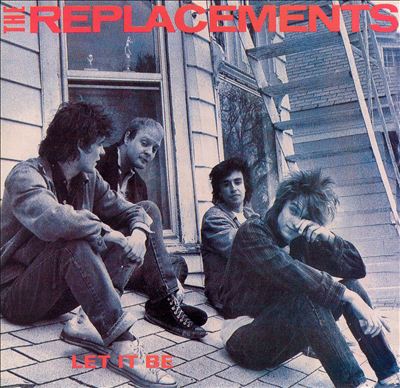 Let It Be - The Replacements, October 1984.
Let It Be - The Replacements, October 1984.
The 'Mats were America's answer to the Sex Pistols, elevating hooliganism to an art form. They were also one of the greatest bands of the college radio era, and Let it Be was their masterpiece. Tim, released the following year, was more musically mature, but Let it Be brims with songcraft and raw emotion. "Seen Your Video" is as violently cathartic as anything by Hüsker Dü, their Minneapolis rivals. "Unsatisfied" is the ultimate Gen-X anthem. Paul Westerberg was the Springsteen of '80s lyricists, and "Sixteen Blue" reveals him as a chord-smith on par with Grant Hart and Bob Mould and whoever wrote R.E.M.'s songs. Let It Be might have been the best album of 1984, if another fellow Minneapolitan hadn't released Purple Rain.
Also recommended: Pleased to Meet Me, from 1987, the last great 'Mats album.
 New Day Rising - Hüsker Dü, January 1985.
New Day Rising - Hüsker Dü, January 1985.
Hüsker Dü was arguably the greatest SST band and one of the three or four most significant artists of the college radio movement, along with R.E.M., the Replacements and the Smiths. I think New Day Rising is their creative peak. I'd place it just above Zen Arcade, the brilliant double album of the previous year, which New Day rivals in energy and exceeds in songcraft. The Hüskers were a double threat, boasting two great songwriters in Hart and Mould. They trade blows here, from the sonic blast of Mould's title cut to the backwoods lunacy of Hart's "The Girl Who Lives on Heaven Hill" to the domestic fury of Mould's "I Apologize," and so on. Put it on your turntable and hang on tight.
Also recommended: Hüsker Dü's trip was all about energy. It faltered with Flip Your Wig, in 1985, and dimmed steadily from there, but the guys dropped some great songs along the way.
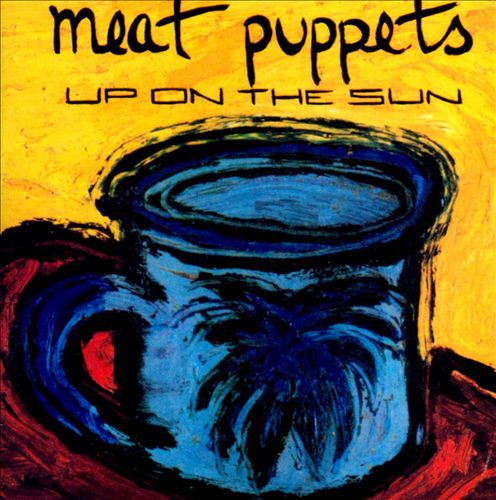 Up on the Sun - Meat Puppets, March 1985.
Up on the Sun - Meat Puppets, March 1985.
I'll get flak for recommending this record above Meat Puppets II, the one Kurt Cobain covered in his famous MTV Unplugged concert. The Meat Puppets were the third great SST band, and all three grew by leaps and bounds in the mid-'80s. With Meat Puppets II (1984), the Arizona post-punkers reveal a dizzying range of artistry, from slam-dance hardcore to virtuosic instrumentals to jam-band psychedelia. With Up on the Sun, the band finds its groove, reeling off a stream of melodic, light-psychedelic guitar-boogie classics. Warm guitar riffs anchor most of the songs, and the Kirkwood brothers adorn them with their unique brand of hypnotic, vaguely off-key harmonies: this is college radio's answer to Disraeli Gears.
Also recommended: Huevos, from 1987, Curt Kirkwood's homage to ZZ Top.
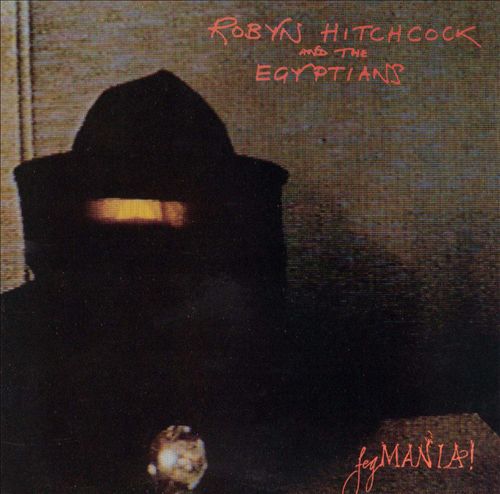 Fegmania! - Robyn Hitchcock, March 1985.
Fegmania! - Robyn Hitchcock, March 1985.
Robyn Hitchcock has had a long and illustrious career, first leading the legendary Soft Boys and then as a remarkably durable solo artist. Not many others on this list have put out great albums in the new millennium. Later releases earned Hitchcock more fame, but Fegmania! is probably his creative peak – or half of it. Hitchcock alternated between electric and acoustic albums. Fegmania! came a year after I Often Dream of Trains, an acoustic collection that is probably his strongest single outpouring of songs. But Trains barely registered in the States. Fegmania! made an impression, landing on the Pazz & Jop poll. All 11 tracks are wonderful. My favorite is "My Wife & My Dead Wife," the sort of song only Hitchcock could dream up, let alone pull off.
Also recommended: Underwater Moonlight, by the Soft Boys; Black Snake Dîamond Röle, the solo debut; the lovely Element of Light; and the enigmatic Eye.
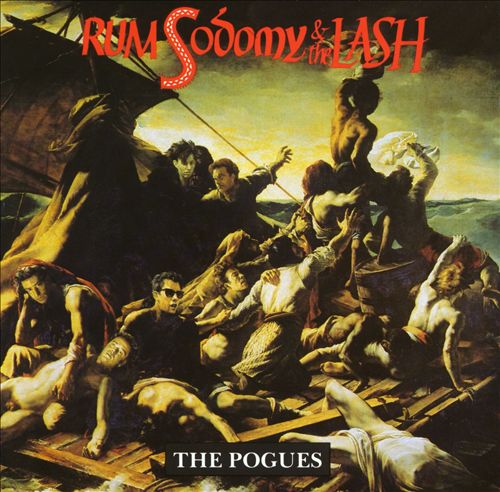 Rum Sodomy & the Lash - The Pogues, August 1985.
Rum Sodomy & the Lash - The Pogues, August 1985.
With the songs "The Old Main Drag" and "A Pair of Brown Eyes" and "Sally MacLennane," the Pogues' Shane MacGowan reeled off new (or new-ish) Irish folk songs that sounded like centuries-old standards, conjuring memories of Fairport-era Richard Thompson and pre-electric Dylan. You'll hear them now in every Irish bar, but in 1985, you mostly heard them on college campuses.
Also recommended: Red Roses for Me, the first LP, is nearly as good. The third, If I Should Fall from Grace with God, is stupendous.
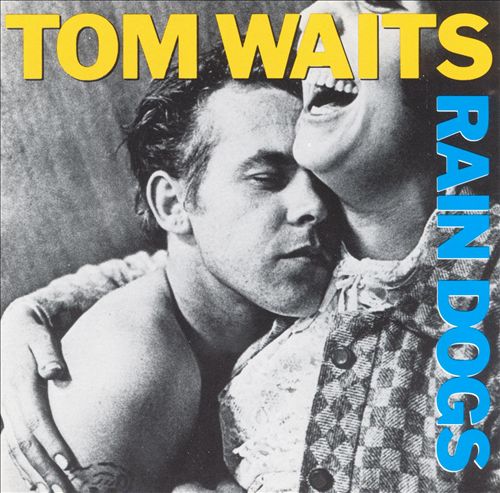 Rain Dogs - Tom Waits, September 1985.
Rain Dogs - Tom Waits, September 1985.
After a decade of smoky piano ballads, Tom Waits reinvented himself as a boho pirate, exploring dozens of instruments, especially percussive instruments, and writing little sea shanties that perfectly fit his guttural Captain Beefheart growl. The first album in this vein was Swordfishtrombones, in 1983, but Rain Dogs was the greater achievement. Supposedly a concept album about New York, Rain Dogs sounds more like the travelogue of a seafarer who's sailed 'round the world. Mood pieces like "Singapore," "Clap Hands" and "Cemetery Polka" – the whole album, frankly – play like the soundtrack for the Pirates of the Caribbean ride in a darker Disneyland.
Also recommended: Everything Waits released from the beginning through Bone Machine (1992) is worth hearing. A lot of the later stuff, too.
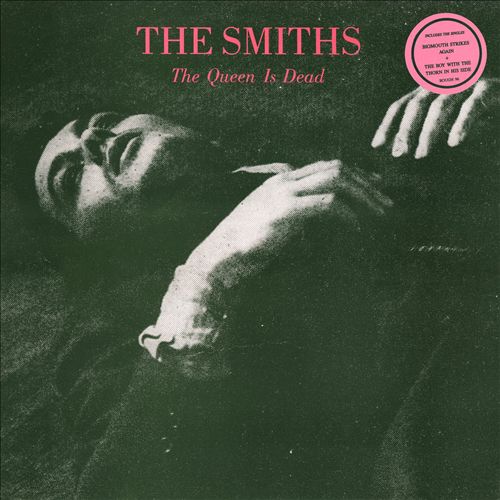 The Queen Is Dead - Smiths, June 1986.
The Queen Is Dead - Smiths, June 1986.
Some Brits think The Queen Is Dead is the greatest rock record ever made. It's certainly the high point for the Smiths, Britain's premier college-radio band. Morrissey and company released a string of extraordinary (and extraordinarily consistent) singles between 1983 and 1987, admirably collected in the Louder Than Bombs double album. That record and this one were absolutely essential to any decent indie record collection. The other Smiths albums were uneven. The 1984 debut is riotous fun; Meat Is Murder (1985) seems more fat than meat. Morrissey was Britain's finest lyricist of the era, and on this album, collaborator Johnny Marr serves up music worthy of his words.
Daniel de Visé is a frequent AllMusic contributor and author of King of the Blues: The Rise and Reign of B.B. King.
Yet, if you walked onto a college campus in the mid-'80s, those bands were everywhere, blaring out of dorm windows, spinning in heavy rotation on college-radio stations at the left of the dial.
Here are 10 great albums of the college-radio era. The list could go on forever, so we'll limit ourselves to LPs that came out between 1983 and 1986, that figured in Robert Christgau's influential yearend Pazz & Jop polls (a measure of impact), and that represent the artist's best work.
(And if you enjoy this piece, consider reading our previous entry on great albums of the new wave era.)
White males dominate the following list, just as they dominated the college-radio underground. Prince, Michael Jackson, Madonna and Run-D.M.C. all released classic albums in those years. They achieved massive, immediate commercial success, and quite rightly so. The discs below did not.
 Murmur - R.E.M., April 1983.
Murmur - R.E.M., April 1983.The release of the first R.E.M. album feels, in hindsight, like the moment college radio arrived. Here was a record filled with brilliant songwriting, infectious hooks, top-drawer vocals and an entirely accessible sound, the qualities that could reliably propel a pop act to fame in prior decades. And the album sold well enough, peaking at No. 36 on the Billboard 200 album chart and yielding a (very) minor hit with "Radio Free Europe." But you weren't going to hear R.E.M. on pop radio, nor see them on MTV. Hence, college radio. Murmur went into heavy rotation on campus radio stations and blasted out of dorm-room speakers. For a large quotient of mid-'80s college students, there was no bigger band.
Also recommended: Each of the three subsequent R.E.M. albums, in gently descending order: Reckoning, Fables of the Reconstruction and Lifes Rich Pageant; and the marvelous Chronic Town EP.
 Violent Femmes - Violent Femmes, April 1983.
Violent Femmes - Violent Femmes, April 1983.The Violent Femmes debut dropped a day after Murmur, and what a week for young hipsters with stereos. "Blister in the Sun," "Add it Up, "Prove My Love" and "Gone Daddy Gone" are immortal folk-punk anthems, utterly irresistible. Violent Femmes may have been the third-best album of 1983, after Murmur and Michael Jackson's Thriller, although the annual Pazz & Jop poll put it at 26.
 Double Nickels on the Dime - Minutemen, July 1984.
Double Nickels on the Dime - Minutemen, July 1984.The idea of a double album from a band called "Minutemen" is funny in itself. (What is that, 80 songs?) But the Minutemen drew inspiration from a pitched creative battle with their talented SST Records labelmates, Hüsker Dü and the Meat Puppets. (See below.) The San Pedro boys were the most down-to-earth of the bunch: When I arrived at Mike Watt's house for an interview, years later, he literally lobbed his bass at me. God help me if I hadn't caught it. Every Minuteman album is good, but this one is probably the best. You get the deathless classics "Corona," "This Ain't No Picnic," "Jesus and Tequila" and, of course, "Political Song for Michael Jackson to Sing."
Also recommended: What Makes a Man Start Fires?, from 1983, kicks off with "Bob Dylan Wrote Propaganda Songs." 3-Way Tie (For Last) is the tragic swansong, released shortly before the death of the great D. Boon.
 Let It Be - The Replacements, October 1984.
Let It Be - The Replacements, October 1984.The 'Mats were America's answer to the Sex Pistols, elevating hooliganism to an art form. They were also one of the greatest bands of the college radio era, and Let it Be was their masterpiece. Tim, released the following year, was more musically mature, but Let it Be brims with songcraft and raw emotion. "Seen Your Video" is as violently cathartic as anything by Hüsker Dü, their Minneapolis rivals. "Unsatisfied" is the ultimate Gen-X anthem. Paul Westerberg was the Springsteen of '80s lyricists, and "Sixteen Blue" reveals him as a chord-smith on par with Grant Hart and Bob Mould and whoever wrote R.E.M.'s songs. Let It Be might have been the best album of 1984, if another fellow Minneapolitan hadn't released Purple Rain.
Also recommended: Pleased to Meet Me, from 1987, the last great 'Mats album.
 New Day Rising - Hüsker Dü, January 1985.
New Day Rising - Hüsker Dü, January 1985.Hüsker Dü was arguably the greatest SST band and one of the three or four most significant artists of the college radio movement, along with R.E.M., the Replacements and the Smiths. I think New Day Rising is their creative peak. I'd place it just above Zen Arcade, the brilliant double album of the previous year, which New Day rivals in energy and exceeds in songcraft. The Hüskers were a double threat, boasting two great songwriters in Hart and Mould. They trade blows here, from the sonic blast of Mould's title cut to the backwoods lunacy of Hart's "The Girl Who Lives on Heaven Hill" to the domestic fury of Mould's "I Apologize," and so on. Put it on your turntable and hang on tight.
Also recommended: Hüsker Dü's trip was all about energy. It faltered with Flip Your Wig, in 1985, and dimmed steadily from there, but the guys dropped some great songs along the way.
 Up on the Sun - Meat Puppets, March 1985.
Up on the Sun - Meat Puppets, March 1985.I'll get flak for recommending this record above Meat Puppets II, the one Kurt Cobain covered in his famous MTV Unplugged concert. The Meat Puppets were the third great SST band, and all three grew by leaps and bounds in the mid-'80s. With Meat Puppets II (1984), the Arizona post-punkers reveal a dizzying range of artistry, from slam-dance hardcore to virtuosic instrumentals to jam-band psychedelia. With Up on the Sun, the band finds its groove, reeling off a stream of melodic, light-psychedelic guitar-boogie classics. Warm guitar riffs anchor most of the songs, and the Kirkwood brothers adorn them with their unique brand of hypnotic, vaguely off-key harmonies: this is college radio's answer to Disraeli Gears.
Also recommended: Huevos, from 1987, Curt Kirkwood's homage to ZZ Top.
 Fegmania! - Robyn Hitchcock, March 1985.
Fegmania! - Robyn Hitchcock, March 1985.Robyn Hitchcock has had a long and illustrious career, first leading the legendary Soft Boys and then as a remarkably durable solo artist. Not many others on this list have put out great albums in the new millennium. Later releases earned Hitchcock more fame, but Fegmania! is probably his creative peak – or half of it. Hitchcock alternated between electric and acoustic albums. Fegmania! came a year after I Often Dream of Trains, an acoustic collection that is probably his strongest single outpouring of songs. But Trains barely registered in the States. Fegmania! made an impression, landing on the Pazz & Jop poll. All 11 tracks are wonderful. My favorite is "My Wife & My Dead Wife," the sort of song only Hitchcock could dream up, let alone pull off.
Also recommended: Underwater Moonlight, by the Soft Boys; Black Snake Dîamond Röle, the solo debut; the lovely Element of Light; and the enigmatic Eye.
 Rum Sodomy & the Lash - The Pogues, August 1985.
Rum Sodomy & the Lash - The Pogues, August 1985.With the songs "The Old Main Drag" and "A Pair of Brown Eyes" and "Sally MacLennane," the Pogues' Shane MacGowan reeled off new (or new-ish) Irish folk songs that sounded like centuries-old standards, conjuring memories of Fairport-era Richard Thompson and pre-electric Dylan. You'll hear them now in every Irish bar, but in 1985, you mostly heard them on college campuses.
Also recommended: Red Roses for Me, the first LP, is nearly as good. The third, If I Should Fall from Grace with God, is stupendous.
 Rain Dogs - Tom Waits, September 1985.
Rain Dogs - Tom Waits, September 1985.After a decade of smoky piano ballads, Tom Waits reinvented himself as a boho pirate, exploring dozens of instruments, especially percussive instruments, and writing little sea shanties that perfectly fit his guttural Captain Beefheart growl. The first album in this vein was Swordfishtrombones, in 1983, but Rain Dogs was the greater achievement. Supposedly a concept album about New York, Rain Dogs sounds more like the travelogue of a seafarer who's sailed 'round the world. Mood pieces like "Singapore," "Clap Hands" and "Cemetery Polka" – the whole album, frankly – play like the soundtrack for the Pirates of the Caribbean ride in a darker Disneyland.
Also recommended: Everything Waits released from the beginning through Bone Machine (1992) is worth hearing. A lot of the later stuff, too.
 The Queen Is Dead - Smiths, June 1986.
The Queen Is Dead - Smiths, June 1986.Some Brits think The Queen Is Dead is the greatest rock record ever made. It's certainly the high point for the Smiths, Britain's premier college-radio band. Morrissey and company released a string of extraordinary (and extraordinarily consistent) singles between 1983 and 1987, admirably collected in the Louder Than Bombs double album. That record and this one were absolutely essential to any decent indie record collection. The other Smiths albums were uneven. The 1984 debut is riotous fun; Meat Is Murder (1985) seems more fat than meat. Morrissey was Britain's finest lyricist of the era, and on this album, collaborator Johnny Marr serves up music worthy of his words.
Daniel de Visé is a frequent AllMusic contributor and author of King of the Blues: The Rise and Reign of B.B. King.